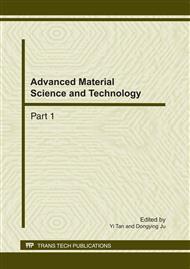[1]
Chaboche, J.L., 1988. Continuum damage mechanics, Part I. ASME J. Appl. Mech. 55, 59-64.
Google Scholar
[2]
Drucker, D.C., 1951. A more fundamental approach to plastic stress-strain relations. In: Proceedins of the 1 U.S. National Congress on Applied Mechanics, pp.487-491.
Google Scholar
[3]
Germain, P., Nguyen, Q.S., Suquet, P., 1983. Continuum thermodynamics. ASME J. Appl. Mech. 50, 1010-1020.
DOI: 10.1115/1.3167184
Google Scholar
[4]
Halphen, B., Nguyen, Q.S. 1975. Sur les matériaux standard généralisés. J. Méca. 14, 39-63.
Google Scholar
[5]
He, Q. -C., Curnier, A., 1995. A more fundamental approach to damaged elastic stress-strain relations. Int. J. Solids Struct. 32, 1433-1457.
DOI: 10.1016/0020-7683(94)00183-w
Google Scholar
[6]
Hill, R., 1970. Constitutive inequalities for isotropic elastic solids under finite strains. Proc. R. Soc. Lond. A. 314, 457-472.
DOI: 10.1098/rspa.1970.0018
Google Scholar
[7]
Krajcinovic, D., 1996. Damage Mechanics. North-Holland, Elsevier, Amsterdam.
Google Scholar
[8]
Krajcinovic, D., 2000. Damage Mechanics: accomplishments, trends and needs. Int. J. Solids Struct. 37, 267-277.
DOI: 10.1016/s0020-7683(99)00081-5
Google Scholar
[9]
Lemaitre, J., 1992. A Course on Damage Mechanics. Springer-Verlag, Berlin.
Google Scholar
[10]
Lubliner, J., 1991. Plasticity Theory. MacMillan Publ., New York.
Google Scholar
[11]
Nguyen, Q.S., Bui, H.D., 1974. Sur les matériaux élastoplastiques à écrouissage positif et négatif. J. Méca. 13, 321-342.
Google Scholar
[12]
Simo, J.C., Ju, J.W., 1987. Strain- and stress-based continuum damage models. I. Formulation. Int. J. Solids Struct. 23, 821-840.
DOI: 10.1016/0020-7683(87)90083-7
Google Scholar
[13]
Truesdell, C., Noll, W., 1992. The Non-linear Field Theories of Mechanics, Second Edition. Springer-Verlag, Berlin.
Google Scholar


